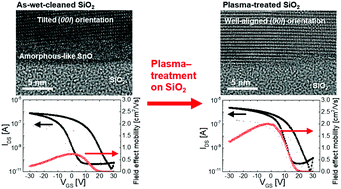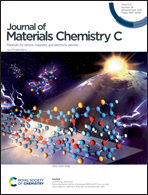Enhancement of electrical performance of atomic layer deposited SnO films via substrate surface engineering†
Abstract
Atomic layer deposition (ALD) is a technique based on the surface reaction of precursors; thus, it strongly depends on the surface states of the substrate. We demonstrate significant changes in the structural and electrical properties of SnO thin films via modification of substrate surface states. The surface of SiO2 exposed to the atmosphere is usually contaminated by organic compounds and lacks hydroxyl groups. The plasma treatment effectively formed numerous functional groups on SiO2, eventually resulting in significant differences in the growth characteristics and properties of ALD-grown SnO films. In the case of a plasma-treated SiO2 substrate, the SnO layer was fully crystallized at the SnO/SiO2 interface, and the (00l) planes of SnO were aligned parallel to the substrate. The numerous functional groups on the plasma-treated SiO2 promoted a complete reaction on the surface, which resulted in the formation of more stoichiometric SnO containing fewer impurities near the interface. The changes in the interfacial properties by the plasma treatment of SiO2 enhanced the field-effect mobility from 0.7 to 2.0 cm2 V−1 s−1 and reduced the hysteresis voltage. The findings may contribute to the realization of complementary oxide thin film devices in future electronics.



 Please wait while we load your content...
Please wait while we load your content...